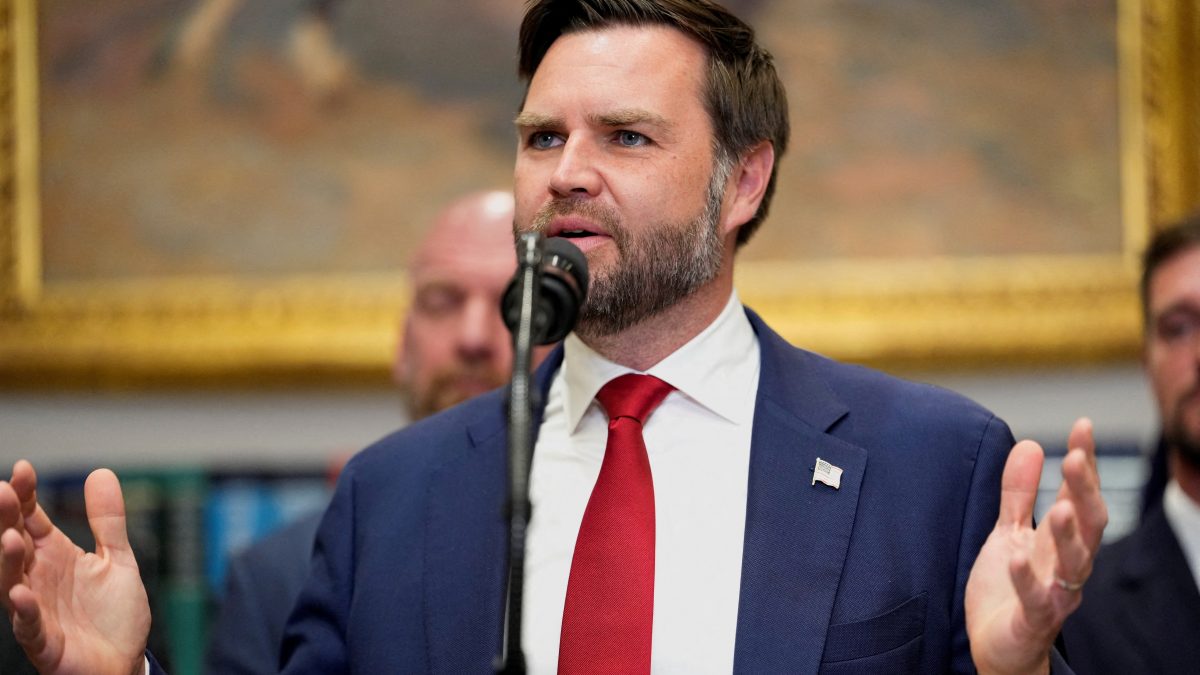US Vice President JD Vance visited a Minneapolis church on Wednesday to express solidarity with the local people in their moment of mourning following the last week’s Minnesota mass shooting. But his visit to Annunciation Catholic Church to honour the victims of the mass shooting that left two children dead and 21 others wounded triggered angry responses from the locals.
While he stepped inside the sanctuary to pray with grieving families, the atmosphere outside the church told a different story. Across the street, demonstrators chanted “do better” and “you’re a coward,” waving pride flags and hoisting placards that read “protect kids not guns”.
The protesters accused the US vice president of offering condolences without backing meaningful action on gun violence, a crisis that has become tragically routine in American life.
Vance meets families of victims
Accompanied by his wife Usha, Vance paused in front of a statue of the Virgin Mary before entering the church. Inside, he listened to parents share stories of their children—their hopes, their laughter, and their lives cut short by gunfire. Speaking afterward, the vice president called the conversations “heartbreaking but also gratifying,” saying he felt honoured to hear the families’ memories.
“I have never had a day that will stay with me like this one,” Vance said.
“We should talk less about the shooter and more about these kids. Their lives were cut short, and that should be the focus.”
The shooter, 23-year-old Robin Westman, opened fire during a school Mass using three legally purchased firearms. Federal officials later confirmed Westman’s identity and noted he had legally changed his name in 2019. The attack has reignited debate over access to guns, particularly when shooters pass background checks despite warning signs.
Anger over inaction
For the protesters gathered outside, grief was inseparable from anger. Their signs—“protect kids, not guns”—captured a frustration that has echoed in communities across the country after similar tragedies. Many questioned whether “thoughts and prayers” from political leaders would ever translate into tougher laws.
Conservative columnist Dustin Grage pushed back online, dismissing the demonstration as “tone-deaf.” But for many in Minneapolis, the chants were not about scoring political points. They were about demanding accountability from those in power.
Impact Shorts
More ShortsVance’s call for prayer and policy
Vance, a practising Catholic, urged Americans to pray for the victims who are still in hospitals receiving treatment. He also pledged to push for policies addressing the “root causes” of such violence, though he stopped short of endorsing new gun restrictions.
“One of the ways I’ll honour these parents is by being a better dad,” Vance said.
“There are families who will never again get that chance.”
The vice president framed the tragedy less as a policy failure than as a cultural and familial one, a distinction that has defined his rhetoric since joining Donald Trump’s ticket.
A pattern of heckling
The disruption in Minneapolis was not an isolated incident. Just two weeks earlier, Vance faced an even more hostile reception in Washington, DC. At Union Station, where he and Defence Secretary Pete Hegseth delivered Shake Shack burgers to National Guard troops, a crowd erupted into jeers.
“Oh look, it’s couch-f***r,” one heckler shouted, referencing a viral but false claim about Vance’s memoir.
The chants grew louder: “Go fk a couch, JD Vance!” and “pyboy.”
Clips of the scene, amplified by Union Station’s cavernous ceilings, ricocheted across social media.
Vance tried to press ahead with his remarks about public safety, dismissing the protesters as “crazy” and accusing them of being privileged, out-of-touch “old white hippies.” His allies, including White House deputy chief of staff Stephen Miller, joined in mocking the crowd.
A viral insult
The “couch” slur traces back to a fabricated claim first posted on X in July 2024. The falsehood, which alleged Vance described a sexual encounter with a couch in his memoir Hillbilly Elegy, spread rapidly online. Despite being debunked, the rumour gained traction after Democratic vice-presidential candidate Tim Walz joked about it at a rally. By late July, Google searches for “JD Vance couch” had outpaced even searches for “Trump shooting.”
The episode illustrates how ridicule has become a potent weapon in the political arena. While critics frame Vance as out of touch with urban communities and unwilling to challenge gun lobby orthodoxy, the viral mockery has added an element of humiliation to his public appearances.
The widening gap
Both in Minneapolis, Minnesota, and in Washington, the heckling highlighted the widening gulf between the Trump-Vance administration and the communities they visit. In D.C., residents protested what they saw as an unwanted militarisation of their city.
In Minnesota, families and activists demanded stronger protections for children from the scourge of gun violence.
For Vance, the challenge is twofold: comforting grieving families while defending an administration that has shown little appetite for sweeping gun reform. His words in Minneapolis—“talk less about the shooter and more about these kids”—may resonate with some. But for protesters chanting outside the church, the call is simple: protecting children means more than prayers.


)

)
)
)
)
)
)
)
)



